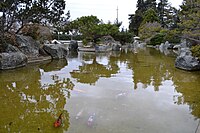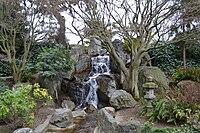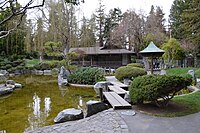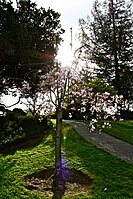
The Guadalupe River mainstem is an urban, northward flowing 14 miles (23 km) river in California whose much longer headwater creeks originate in the Santa Cruz Mountains. The river mainstem now begins on the Santa Clara Valley floor when Los Alamitos Creek exits Lake Almaden and joins Guadalupe Creek just downstream of Coleman Road in San Jose, California. From here it flows north through San Jose, where it receives Los Gatos Creek, a major tributary. The Guadalupe River serves as the eastern boundary of the City of Santa Clara and the western boundary of Alviso, and after coursing through San José, it empties into south San Francisco Bay at the Alviso Slough.

Japanese gardens are traditional gardens whose designs are accompanied by Japanese aesthetics and philosophical ideas, avoid artificial ornamentation, and highlight the natural landscape. Plants and worn, aged materials are generally used by Japanese garden designers to suggest a natural landscape, and to express the fragility of existence as well as time's unstoppable advance. Ancient Japanese art inspired past garden designers. Water is an important feature of many gardens, as are rocks and often gravel. Despite there being many attractive Japanese flowering plants, herbaceous flowers generally play much less of a role in Japanese gardens than in the West, though seasonally flowering shrubs and trees are important, all the more dramatic because of the contrast with the usual predominant green. Evergreen plants are "the bones of the garden" in Japan. Though a natural-seeming appearance is the aim, Japanese gardeners often shape their plants, including trees, with great rigour.

Hakone Gardens is an 18-acre (7.3 ha) traditional Japanese garden in Saratoga, California, United States. A recipient of the Save America's Treasures Award by the National Trust for Historic Preservation, it is recognized as one of the oldest Japanese-style residential gardens in the Western Hemisphere. Notable features include a bamboo garden, a Zen garden, a strolling garden, tea houses, and the Cultural Exchange Center, which is an authentic reproduction of a 19th-century Kyoto tea merchant's house and shop.

Kelley Park is a 156-acre (63 ha) city park in San Jose, California, United States.
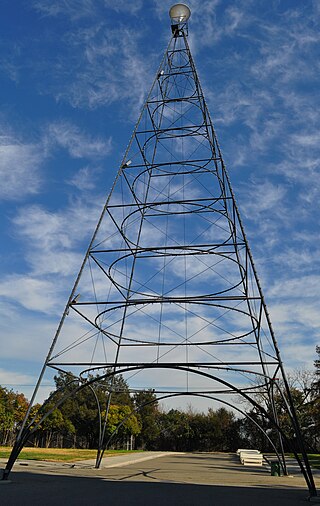
History Park at Kelley Park in San Jose, California, USA is designed as an indoor/outdoor museum, arranged to appear as a small US town might have in the early 1900s (decade). Since its inauguration in 1971, 32 historic buildings and other landmarks have either been moved from their original San Jose locations or are represented by replicas.

Kōraku-en is a Japanese garden located in Okayama, Okayama Prefecture. It is one of the Three Great Gardens of Japan, along with Kenroku-en and Kairaku-en. Korakuen was built in 1700 by Ikeda Tsunamasa, lord of Okayama. The garden reached its modern form in 1863.

Coyote Creek is a river that flows through the Santa Clara Valley in Northern California. Its source is on Mount Sizer, in the mountains east of Morgan Hill. It eventually flows into Anderson Lake in Morgan Hill and then northwards through Coyote Valley to San Jose, where it empties into San Francisco Bay.

The Portland Japanese Garden is a traditional Japanese garden occupying 12 acres, located within Washington Park in the West Hills of Portland, Oregon, United States. It is operated as a private non-profit organization, which leased the site from the city in the early 1960s. Stephen D. Bloom has been the chief executive officer of the Portland Japanese Garden since 2005.

The River Crane, a tributary of the River Thames, runs 8.5 miles (13.6 km) in West London, England. It forms the lower course of Yeading Brook. It adjoins or passes through three London boroughs: Hillingdon, Hounslow and Richmond upon Thames, in the historic county of Middlesex. The drainage basin is heavily urbanised but many of the Hayes to Whitton flood-meadows have been conserved, forming a narrow, green vale, opening out to what remains of Hounslow Heath in the centre – a near-continuous belt of semi-natural habitat.

The Japanese Tea Garden in San Francisco, California, is a popular feature of Golden Gate Park, originally built as part of a sprawling World's Fair, the California Midwinter International Exposition of 1894. Though many of its attractions are still a part of the garden today, there have been changes throughout the history of the garden that have shaped it into what it is today.

Okayama is the capital city of Okayama Prefecture in the Chūgoku region of Japan. The Okayama metropolitan area, centered around the city, has the largest urban employment zone in the Chugoku region of western Japan. The city was founded on June 1, 1889. As of February 2023, the city has an estimated population of 700,940 and a population density of 890 persons per km2. The total area is 789.95 square kilometres.

The Japanese Friendship Garden is a Japanese stroll garden in Phoenix, Arizona, known as Rohō-en (鷺鳳園) in Japanese. The garden encompasses 3.5 acres (14,000 m2) and includes a tea garden and tea house. It is a joint project of the sister cities Phoenix and Himeji.

Established in 1982, the California Trolley and Railroad Corporation (CTRC) is a 501(c)(3) non-profit organization to preserve rail transportation in the Santa Clara Valley.
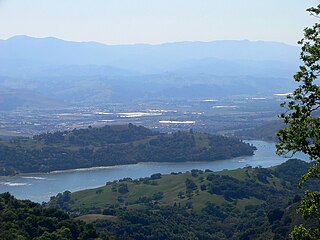
Anderson Lake, also known as Anderson Reservoir, is an artificial lake in Morgan Hill, located in southern Santa Clara County, California. The reservoir is formed by the damming of Coyote Creek just below its confluence with Las Animas Creek. A 4,275-acre (1,730 ha) county park surrounds the reservoir and provides limited fishing, picnicking, and hiking activities. Although swimming is prohibited, boating, water-skiing, and jet-skiing are permitted in the reservoir.
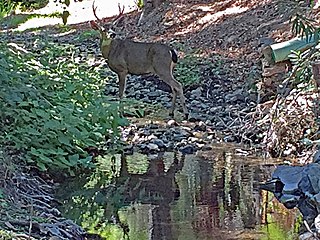
Permanente Creek is a 13.3-mile-long (21.4 km) stream originating on Black Mountain in Santa Clara County, California, United States. Named by early Spanish explorers as Arroyo Permanente or Río Permanente because of its perennial flow, the creek descends the east flank of Black Mountain then courses north through Los Altos and Mountain View, discharging into southwest San Francisco Bay historically at the Mountain View Slough but now virtually entirely diverted via the Permanente Creek Diversion Channel to Stevens Creek and Whisman Slough in San Francisco Bay.

The Japanese Friendship Garden is a Japanese garden in Balboa Park in San Diego, California. The garden is an expression of friendship between San Diego and its sister city Yokohama.

Washington SyCip Park is a privately owned public park near Greenbelt mall in Legaspi Village, Makati, Metro Manila, Philippines. The park opened in 2006, and was named after Filipino accountant and banker Washington SyCip. In addition to many indigenous tropical trees and plants, the park contains gazebos and recreational spaces.

Central Park is the first public park in San Mateo, California, a 16.5-acre (7 ha) urban park bounded by El Camino Real, 5th Avenue, Laurel Avenue and 9th Avenue. It was established via a 1922 bond measure of US$80,000 to purchase the land originally owned by Charles B. Polhemus, and currently hosts a baseball field, tennis courts, sculptures, playground, Japanese tea garden, recreation center, miniature train, rose garden and the San Mateo Arboretum.
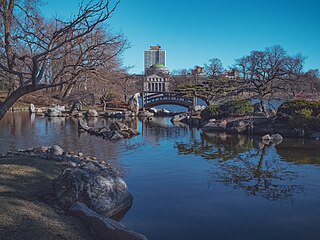
Garden of the Phoenix is a Japanese garden on the grounds of Jackson Park in Chicago. Originally created in 1893, its current name dates to 2013.



